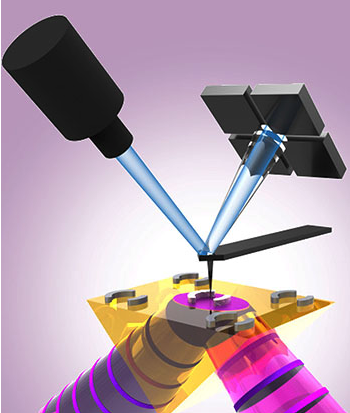Members Login

Channels
Special Offers & Promotions
NIST Researchers Enabled by AFM-IR to Publish first Nanoscale IR Spectra of Individual Plasmonic Nanostructures
Anasys Instruments reports on the new AFM-IR results from the Energy Research Group at NIST just published in the journal for Advanced Optical Materials. The paper is entitled “Nanoscale imaging and spectroscopy of plasmonic modes with the PTIR technique.”
 Researchers from the NIST Center for Nanoscale Science and Technology (CNST) and the University of Maryland have used photothermal induced resonance (PTIR) to characterize individual plasmonic nanomaterials in order to obtain absorption maps and the first examples of absorption spectra with nanometer-scale resolution. Nanostructuring of plasmonic materials enables engineering of their resonant optical response and creates new opportunities for applications that benefit from enhanced light-matter interactions, including sensing, photovoltaics, photocatalysis, and therapeutics.
Researchers from the NIST Center for Nanoscale Science and Technology (CNST) and the University of Maryland have used photothermal induced resonance (PTIR) to characterize individual plasmonic nanomaterials in order to obtain absorption maps and the first examples of absorption spectra with nanometer-scale resolution. Nanostructuring of plasmonic materials enables engineering of their resonant optical response and creates new opportunities for applications that benefit from enhanced light-matter interactions, including sensing, photovoltaics, photocatalysis, and therapeutics.
Project Leader, Andrea Centrone and his co-workers in the Energy Research Group at NIST used a technique called photothermally induced resonance (PTIR) where an AFM tip is used as an IR absorbance detector thus enabling nanoscale IR spectroscopy. Since the PTIR signal is not affected by scattering, PTIR spectra are free of Fano spectral distortions typically observed in the far-field.
Commenting on the work, Centrone says “we showed that PTIR characterization is not just applicable to organics, insulators and semiconductors, as demonstrated previously, but that metals are also amenable to it. This is an important step forward for applying the PTIR technique to a wider variety of functional devices.”
PTIR is at the core of the nanoIR platform developed and supplied by Anasys Instruments for this work. Now in its second generation, the nanoIR2 combines key elements of both nanoscale IR spectroscopy and atomic force microscopy (AFM) to enable IR spectroscopy and imaging on the nanoscale. In addition to revealing chemical composition, the nanoIR2 system provides high-resolution characterization of local topographic, mechanical, and thermal properties. Potential application areas span the realms of polymer science, materials science, and life science, including detailed studies of structure property correlations.
more news from anasys instruments
Media Partners


